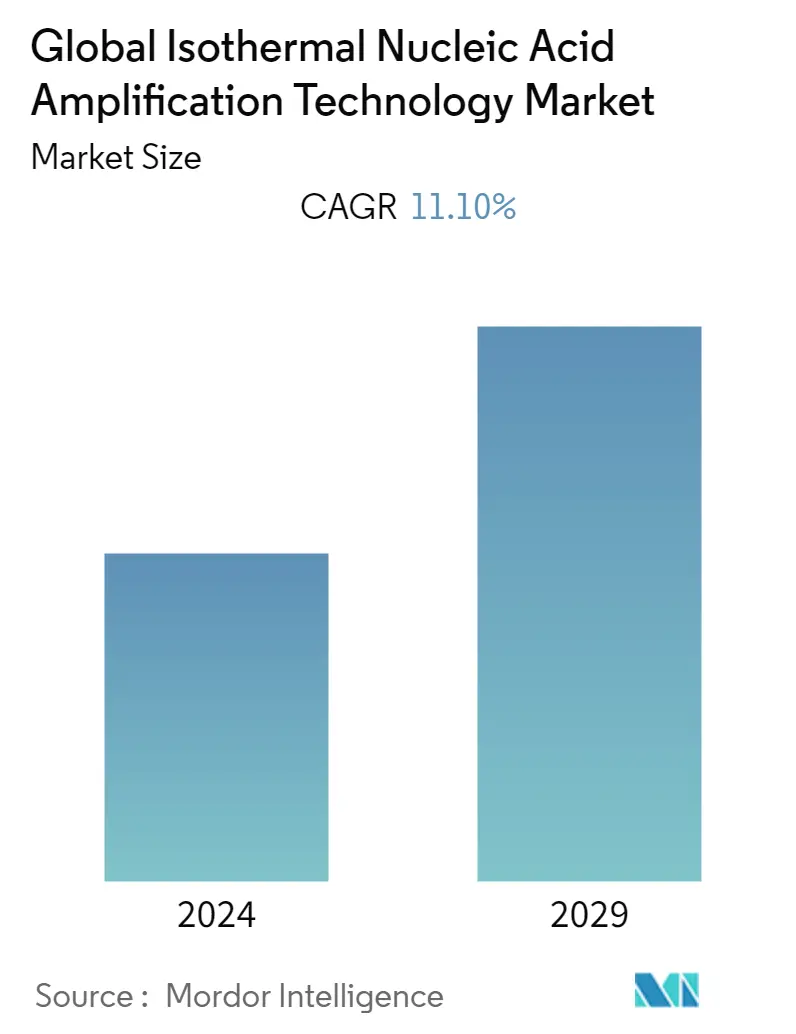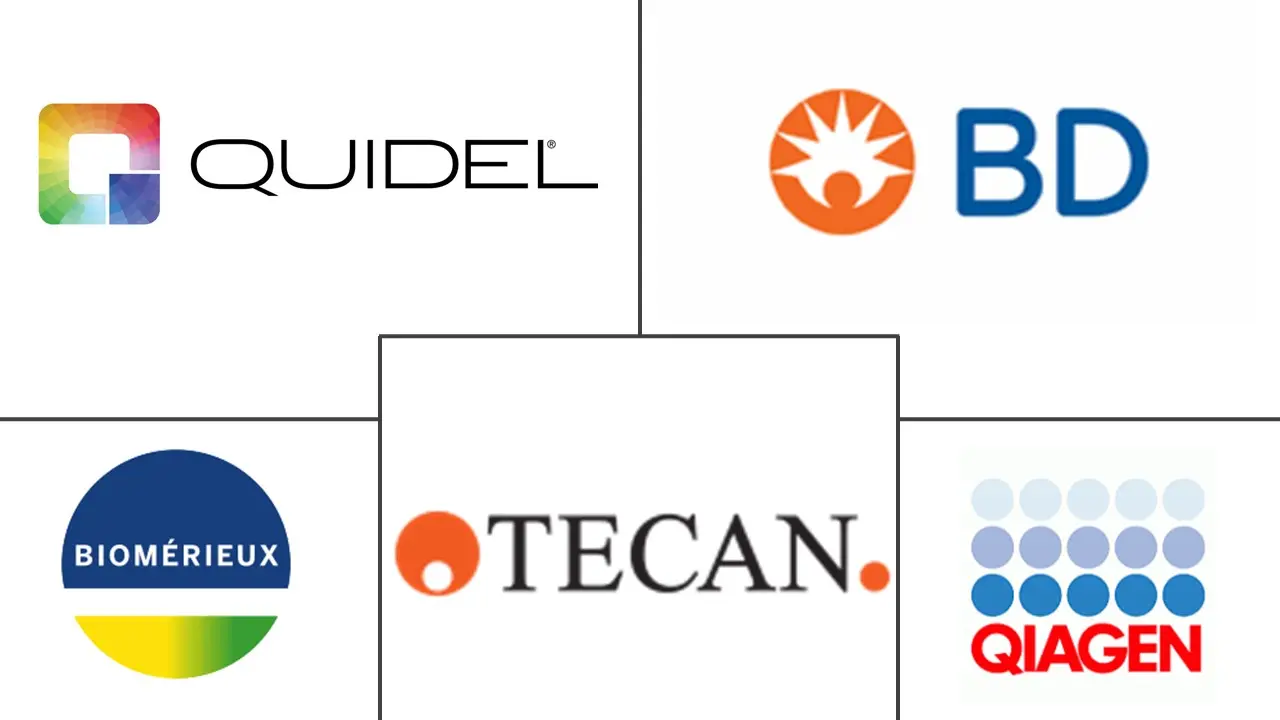Market Size of Global Isothermal Nucleic Acid Amplification Technology Industry

| Study Period | 2019 - 2029 |
| Base Year For Estimation | 2023 |
| CAGR | 11.10 % |
| Fastest Growing Market | Asia Pacific |
| Largest Market | North America |
| Market Concentration | Medium |
Major Players
*Disclaimer: Major Players sorted in no particular order |
Isothermal Nucleic Acid Amplification Technology (INAAT) Market Analysis
The Isothermal Nucleic Acid Amplification Technology (INAAT) Market is expected to register a CAGR of 11.1% during the forecast period 2022-2027.
COVID-19 is expected to have a significant impact on the growth of the market. The COVID-19 pandemic observed isothermal methods implemented as a basic technology used for the diagnosis of SARS-CoV-2 RNA in home and clinical testing centers. Furthermore, in March 2020, Abbott received the United States Food and Drug Administration approval for the Emergency use of ID NOW COVID-19, an instrument-based, isothermal, rapid system for the qualitative finding of disease. Thus increased utilization during pandemic and product approvals and launches are expected to accelearte the growth of the market during the forecast period.
The increasing incidences of chronic diseases and an aging population, an increase in the adoption of INAAT over PCR, and a rise in demand for low-cost and effective diagnostics procedures are some of the major factors that are driving the growth of the market studied. According to the World Health Organization report in February 2022, Cancer was one of the major cause of death worldwide. The report states that Each year, approximately 400,000 children develop cancer in which cervical cancer is the most common in 23 countries. The report Published by International Agency for Research on Cancer (IARC) in December 2020 that the global cancer burden has risen to 19.3 million cases. and thus, due to the high prevalence of cancer around the world, the demand for effective therapy or treatment is increasing which is expected to drive the growth of the market.
Nucleic acid amplification has several applications in the healthcare industry starting from research to clinics. Until now, PCR has been the most widely-used amplification technology across the world. A thermal cycler is required in PCR, as various temperatures need to be maintained at different steps of the amplification process. Additionally, contaminants must be removed for effective amplification through this technology. The thermal cycler itself is costly, and sample preparation to remove contaminants from the sample makes the overall process more costly and time-consuming.
Owing to this high cost, the technique has witnessed limited adoption in developing countries, where the demand for this technology is extremely high, especially for clinical application. This high demand has led to the development of novel innovative techniques, such as isothermal nucleic acid amplification technology.
The isothermal technique, as the name suggests, is performed at a fixed temperature. This temperature can vary depending on the type of nucleic acid. The tedious task of preparing a sample is not required, as the technology can take a sample directly for amplification. Additionally, the technology is affordable, making it accessible for people belonging to different economic levels across the world. The low-cost associated with technology is likely to result in increased adoption, especially in the developing regions.
Hence, owing to the cost benefits and the use of novel technologies, INAAT market is expected to grow in the coming future.
Isothermal Nucleic Acid Amplification Technology (INAAT) Industry Segmentation
As per the scope of the report, nucleic acid amplification technologies are used in the field of molecular biology and recombinant DNA technologies. These techniques are used as leading methods in detecting and analyzing a small number of nucleic acids. Isothermal nucleic acid amplification technology protocols are varied, and have many advantages, as it is extremely fast and does not require thermocyclers. The Isothermal Nucleic Acid Amplification Technology (INAAT) Market is segmented By Technology(Helicase-dependant Amplification(HDA), Nicking Enzyme Amplification Reaction(NEAR), Loop-mediated Isothermal Amplification(LAMP), Strand Displacement Amplification (SDA), Nucleic Acid Sequence-based Amplification(NASBA), Transcription Mediated Amplification (TMA), Single Primer Isothermal Amplification(SPIA), Other Technologies), By Product(Instruments and Reagent), By End-User (Hospital, Research laboratories, Other End-Users), and Geography (North America, Europe, Asia-Pacific, Middle East and Africa, and South America). The market report also covers the estimated market sizes and trends for 17 different countries across major regions, globally. The report offers the value (in USD million) for the above segments.
| By Technology | |
| Helicase-dependent Amplification (HDA) | |
| Nicking Enzyme Amplification Reaction (NEAR) | |
| Loop-mediated Isothermal Amplification (LAMP) | |
| Strand Displacement Amplification (SDA) | |
| Nucleic Acid Sequence-based Amplification (NASBA) | |
| Transcription Mediated Amplification (TMA) | |
| Single Primer Isothermal Amplification (SPIA) | |
| Other Technologies |
| By Product | |
| Instruments | |
| Reagents |
| By End-User | |
| Hospitals | |
| Research Laboratories | |
| Other End-Users |
| Geography | ||||||||
| ||||||||
| ||||||||
| ||||||||
| ||||||||
|
Global Isothermal Nucleic Acid Amplification Technology Market Size Summary
The Isothermal Nucleic Acid Amplification Technology (INAAT) market is poised for significant growth, driven by its increasing adoption over traditional PCR methods and the rising demand for cost-effective diagnostic solutions. The COVID-19 pandemic has accelerated the adoption of INAAT, as it was utilized for rapid SARS-CoV-2 RNA detection, leading to product approvals and launches that are expected to bolster market expansion. The technology's ability to operate at a fixed temperature without the need for a thermal cycler makes it more accessible and affordable, particularly in developing regions where healthcare costs are a concern. This accessibility is further enhanced by the technology's application in various healthcare settings, from research to clinical diagnostics, and its capability to amplify both DNA and RNA, making it versatile for different diagnostic needs.
North America currently leads the INAAT market, supported by a high prevalence of chronic diseases and technological advancements in the region. The growing elderly population and the increasing incidence of cancer globally are also contributing to the market's expansion, as there is a heightened demand for effective diagnostic and therapeutic solutions. The market is characterized by a consolidated nature with major global players like Becton Dickinson and Company, Qiagen NV, and bioMerieux, while emerging markets in countries like China and India are expected to see local players entering the market. Innovations such as the Loop-mediated Isothermal Amplification (LAMP) technique are gaining traction due to their competitive advantages over PCR, including tolerance to inhibitors and the elimination of the need for complex equipment, thereby supporting the growth of point-of-care diagnostics.
Global Isothermal Nucleic Acid Amplification Technology Market Size - Table of Contents
-
1. MARKET DYNAMICS
-
1.1 Market Overview
-
1.2 Market Drivers
-
1.2.1 Increasing Incidences of Chronic Diseases And Aging Population
-
1.2.2 Increase in the Adoption of INAAT Over PCR
-
1.2.3 Rise In The Miniaturization of Nucleic Acid-based Diagnostics
-
1.2.4 Rise In Demand for Low-cost And Effective Diagnostics Procedures
-
-
1.3 Market Restraints
-
1.3.1 Threatening Opposition from PCR Technologies
-
1.3.2 Lack of Awareness about New Diagnostics Technologies
-
-
1.4 Porter's Five Force Analysis
-
1.4.1 Threat of New Entrants
-
1.4.2 Bargaining Power of Buyers/Consumers
-
1.4.3 Bargaining Power of Suppliers
-
1.4.4 Threat of Substitute Products
-
1.4.5 Intensity of Competitive Rivalry
-
-
-
2. MARKET SEGMENTATION (Market Size by Value - USD million)
-
2.1 By Technology
-
2.1.1 Helicase-dependent Amplification (HDA)
-
2.1.2 Nicking Enzyme Amplification Reaction (NEAR)
-
2.1.3 Loop-mediated Isothermal Amplification (LAMP)
-
2.1.4 Strand Displacement Amplification (SDA)
-
2.1.5 Nucleic Acid Sequence-based Amplification (NASBA)
-
2.1.6 Transcription Mediated Amplification (TMA)
-
2.1.7 Single Primer Isothermal Amplification (SPIA)
-
2.1.8 Other Technologies
-
-
2.2 By Product
-
2.2.1 Instruments
-
2.2.2 Reagents
-
-
2.3 By End-User
-
2.3.1 Hospitals
-
2.3.2 Research Laboratories
-
2.3.3 Other End-Users
-
-
2.4 Geography
-
2.4.1 North America
-
2.4.1.1 United States
-
2.4.1.2 Canada
-
2.4.1.3 Mexico
-
-
2.4.2 Europe
-
2.4.2.1 Germany
-
2.4.2.2 United Kingdom
-
2.4.2.3 France
-
2.4.2.4 Italy
-
2.4.2.5 Spain
-
2.4.2.6 Rest of Europe
-
-
2.4.3 Asia-Pacific
-
2.4.3.1 China
-
2.4.3.2 Japan
-
2.4.3.3 India
-
2.4.3.4 Australia
-
2.4.3.5 South Korea
-
2.4.3.6 Rest of Asia-Pacific
-
-
2.4.4 Middle-East and Africa
-
2.4.4.1 GCC
-
2.4.4.2 South Africa
-
2.4.4.3 Rest of Middle-East and Africa
-
-
2.4.5 South America
-
2.4.5.1 Brazil
-
2.4.5.2 Argentina
-
2.4.5.3 Rest of South America
-
-
-
Global Isothermal Nucleic Acid Amplification Technology Market Size FAQs
What is the current Global Isothermal Nucleic Acid Amplification Technology Market size?
The Global Isothermal Nucleic Acid Amplification Technology Market is projected to register a CAGR of 11.10% during the forecast period (2024-2029)
Who are the key players in Global Isothermal Nucleic Acid Amplification Technology Market?
Becton Dickinson and Company, Qiagen NV, BioMerieux SA, Quidel Corporation and Tecan Genomics, Inc. are the major companies operating in the Global Isothermal Nucleic Acid Amplification Technology Market.

